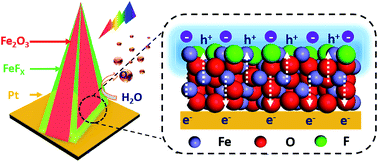Ultrathin FeFx nanolayers accelerating hole transfer for enhanced photoelectrochemical water oxidation†
Abstract
In photoelectrochemical (PEC) water splitting systems, the sluggish oxygen evolution reaction (OER) kinetics dominated by hole transfer greatly limits the photo-conversion efficiency. Herein, we demonstrate the in situ growth of ultrathin FeFx nanolayers on Fe2O3 photoanodes, acting as a highly efficient OER cocatalyst to accelerate hole transfer for improved PEC activity. By virtue of its ultrathin structure and high electronegativity, ultrathin FeFx not only promotes the rapid hole transfer among the anode/cocatalyst interfaces but also maximizes the contact areas between the electrode and the reactants. As expected, this photoanode exhibits a remarkably improved photocurrent density of 2.4 mA cm−2 at 1.23 V (reversible hydrogen electrode, AM 1.5 G), up to 12 times enhancement with respect to the pristine Fe2O3 sample. Moreover, a notably negative shift (0.1 VRHE) on the onset potential has been simultaneously achieved. This work represents a new, simple and highly efficient approach to suppress charge recombination and accelerate the hole transfer for water oxidation, which may serve as an alternate candidate for creating high-efficiency PEC water splitting systems.



 Please wait while we load your content...
Please wait while we load your content...